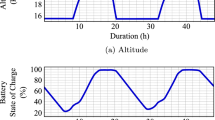Abstract
A solar-powered mini-UAV has been designed for long-endurance performance at low altitude, reflecting practical constraints from preceding experience of authors. The parametric analysis of the solar-power propulsion system is the primary interest of the present study, along with the power requirement estimation of the aircraft design. To cope with the wide range of flight speed, low-Reynolds number airfoils are selected, which possesses low drag characteristics at wide range of angle of attack. Aerodynamic design studies point out that maintaining Reynolds number above 100,000 is a requisite for extended flight operations of the solar-powered mini-UAV. The itemized drag prediction of the UAV design is performed based on the Xflr5 analysis of the UAV configuration. The solar modules and battery systems of the UAV design are represented as equivalent electric models, for the performance simulation of the solar-power propulsion system. Rigorous analyses on the seasonal solar radiation indicate that the capacity of the battery pack should be increased over 50% of the current design to provide continuous operation of the mini-UAV up to 60 days.
















Similar content being viewed by others
Abbreviations
- \( \alpha_{ \rm{max} } \) :
-
Incident angle of sunlight
- \( I_{ \rm{max} } \) :
-
Maximum irradiance
- \( I_{\text{DN}} \) :
-
Direct normal irradiation
- \( T_{\text{day}} \) :
-
The duration of sunshine
- \( T_{\text{sunrise}} \) :
-
The time of sunrise
- \( {\text{t}} \) :
-
Flight time
- \( Re \) :
-
Reynolds number
- \( S_{\text{wet,Tailboom}} \) :
-
Wetted area of tail boom
- \( S_{\text{platearea}} \) :
-
Interference area
- \( C_{\text{L}} \) :
-
Lift coefficient
- \( e \) :
-
Oswald’s coefficient
- \( {\text{AR}} \) :
-
Aspect ratio
- \( C_{\text{D,i}} \) :
-
Induce drag coefficient
- \( C_{\text{D,Interference}} \) :
-
Interference drag coefficient
- \( C_{\text{D,Tailboom}} \) :
-
Tail boom drag coefficient
- \( I_{\text{ph}} \) :
-
Photocurrent
- \( I_{\text{d}} \) :
-
Diode current
- \( N_{\text{S}} \) :
-
Number of cells connected in series
- \( V_{\text{T}} \) :
-
Diode thermal voltage
- \( T_{\text{C}} \) :
-
Actual cell temperature
- \( K \) :
-
Boltzmann constant
- \( q \) :
-
Electron charge
- \( A \) :
-
Ideality factor
- \( a \) :
-
Modified ideality factor
- \( I_{p} \) :
-
Current leak in parallel resistor
- \( I_{0} \) :
-
Reverse saturation or leakage current
- G :
-
Irradiance
- \( \mu_{\text{sc}} \) :
-
Coefficient temperature of short circuit current
- \( V_{\text{OC}} \) :
-
Open circuit voltage
- \( I_{\text{SC}} \) :
-
Short circuit current
References
Boucher RJ (1985) Sunrise, the world’s first solar-powered airplane. J Aircr 22(10):840–846
Airbus S.A.S web page (2018) Zephyr, Pioneering the Stratosphere. https://www.airbus.com/defence/uav/zephyr.html. Accessed 2018
Ahn J, Kim N, Lee S (1990) Preliminary design of a solar powered HALE airplane. J Korean Soc Aeronaut Space Sci 18(2):90–98
Ahn H, Ahn J (2017) Performance analysis of a small solar powered UAV considering design variables. In: Proceedings of 2017 Korean Society for Aeronautical and Space Sciences Spring conference, pp 59–61
Gudmumdsson S (2014) General aviation aircraft design: applied methods and procedure, 1st edn. Elsevier, New York
Nguyen XH, Nguyen MP (2015) Mathematical modeling of photovoltaic cell/module/arrays with tags in Matlab/Simulink. Environ Syst Res 4:24
Noth A (2008) Design of solar powered airplanes for continuous flight. Dissertation of Doctor of Technical Sciences, ETH Zurich, 2008
Habati B, Ramdani Y, Moulay F (2014) A detailed modeling of photovoltaic module using MATLAB. J Natl Res Inst Astron Geophys 3(1):53–61
SunPower Corporation product brochure “SunPower C60 Solar Cell”. http://eshop.terms.eu/_data/s_3386/files/1379942540-sunpower_c60_bin_ghi.pdf. Accessed 2018
Ahn J (2011) Conceptual design and performance analysis of a solar powered HALE UAV considering practical constraints. In: Proceedings of 2017 Korean Society for Aeronautical and Space Sciences Fall Conference, pp 379–382
Guangtong X, Li L, Xiaohui Z (2016) Modeling and performance analysis for low altitude electric UAVs. In: Proceedings of international conference on civil, transportation and environment, pp 1058–1065
Vyroubal P, Maxa J, Kazda T (2014) Simulation of the behavior of the lithium ion battery. Adv Mil Technol 9(1):107–115
Acknowledgements
This study was conducted with supports from the project of Ministry of Science, ICT and Future Planning (2016937799), “Development of High Efficiency/Low Noise Propeller Design for Multi-Copter Small UAV”. The authors would like to present a sincere gratitude to the people of Unmanned Vehicle Advanced Research Center (UVARC) of Korea Aerospace Research Institute (KARI), Daejon, Korea.
Author information
Authors and Affiliations
Corresponding author
Rights and permissions
About this article
Cite this article
Ahn, H., Ahn, J. Design and Analysis of a Solar-Power Mini-UAV for Extended Endurance at Low Altitude. Int. J. Aeronaut. Space Sci. 20, 561–569 (2019). https://doi.org/10.1007/s42405-018-0132-1
Received:
Revised:
Accepted:
Published:
Issue Date:
DOI: https://doi.org/10.1007/s42405-018-0132-1




